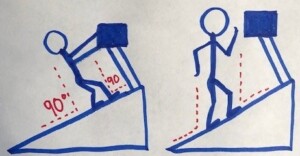
A morbidly obese woman couldn’t understand why she got fat despite pushing her baby “tons and tons” in a stroller.
She also said she spent two hours a day walking a treadmill at the highest incline. Her article says she was around 300 pounds. See the screenshot excerpt below.
![]()
First of all, when someone says “tons and tons,” this is to be taken with a grain of salt. She’s a single mother with a full-time job and nobody helping her out.
So when she says “tons and tons,” this is likely more perception than actual loads of time on a daily basis committed to pushing the stroller.
What may seem like pushing a stroller tons and tons might actually amount to only 30 minutes or so most days of the week.
It’s a common phenomenon for people to unknowingly exaggerate how much they exercise.
However, what about the actual activity of pushing a stroller, regardless whether it’s half an hour daily or two hours daily?
Manufacturers of strollers want their users to find the task as easy as possible. Otherwise, they wouldn’t be able to sell their strollers.
Hence, strollers are designed for very easy pushing. This is not hard work. If it were, strollers wouldn’t sell well.
“Unfortunately, pushing your baby in a stroller isn’t likely to make you lose fat or stay slim,” says Supriya Rao, MD, director of Medical Weight Loss at Lowell General Hospital and managing director of Integrated Gastroenterology Consultants.
“While it’s great exercise and healthy for your body, it’s not enough to burn off the calories you consume.
“Instead, you’ll need to combine a healthy diet with regular physical activity to lose weight and keep it off.
“Pushing a stroller can be an excellent form of exercise, as it is low-impact and puts less strain on your body than running or jogging.
“First, however, it’s important to know how many calories you burn while pushing your baby in a stroller.
“The average person will burn around 4-5 calories per minute while pushing a stroller, compared to the 8-12 calories burned per minute when running.
“If you want to lose weight while pushing your baby in a stroller, you’ll need to combine that activity with other forms of exercise and make sure that you are eating a healthy, balanced diet.”
Look at it this way: Pushing a baby in a stroller is not like pushing a pile of rocks or bricks in a wheelbarrow.
Pushing something heavy from point A to point B is actually a great form of exercise, which is why sled pushing is becoming more common at conventional gyms.

Sled pushing: a whole-body workout. Freepik.com/Drazen Zigic
But please, do not equate sled pushing with stroller pushing! The weight of the stroller’s occupant is hardly felt.
What about those strollers that are designed for pushing while jogging?
This is great exercise, because the user is actually jogging. But in the morbidly obese woman’s case, she was only walking.
How fast was she pushing the stroller? She didn’t say in her article. She only said “tons and tons.”
Was she pushing it up a lot of hills? Again, we don’t know. However, pushing a stroller up a hill is good exercise for weight loss! This is because you’re walking up a hill.
Brisk walking on flat land is good exercise for the heart, but it doesn’t rank well for weight loss.
But there’s also an element we can’t dismiss: Fast walking for an obese person is hard work, because she’s propelling 300 pounds through space.
This can help her lose some weight, but it won’t be the magic bullet. The magic bullets are portion control of food, intense strength training, and high intensity interval training on a pedaling machine — or walking a treadmill incline without holding on: both safe modes for the knees.
Furthermore, we shouldn’t expect a morbidly obese woman to jog anyways, as this would be extremely arduous, and not safe for her knees.
Walking and pedaling are good modes of exercise for morbidly obese people. If they have a baby or toddler, they can combine the enjoyment of pushing a stroller with accumulating walking distance on a daily basis.
However, she must be realistic: A lot of pushing of a stroller will not make her drop a hundred pounds.
Furthermore, something tells me that the author didn’t do the “tons and tons” at her fastest possible speed, or, to put another way, a speed that kept her continuously breathing hard.
She likely pushed that stroller (come on, let’s be realistic) at “stroller pace,” which is the pace you see any woman, regardless of size, pushing a stroller.
As for the two hours a day on a treadmill’s highest incline, I’ll be she was tightly holding on for every minute of those two hours.
All the time I see people who are straight size and slender clinging to the treadmill at high inclines. They’re tilted back as a result, and this CANCELS OUT THE INCLINE.

Holding on cancels out the incline.
You might be thinking, though, “Well, it’s still a two-hour walk, isn’t it? It’s still better than nothing, isn’t it?”
Yes, it’s a two-hour walk, but with the assistance of holding onto something. The calorie readout on the machine is grossly inflated, and it’s triggered by the machine’s settings.
If you let a treadmill run at high incline and 4 mph without anyone on it, it will still show the same high calorie readout!
The higher the incline, the tighter people hold on, making what appears to be a kick-butt walk an easy one. It won’t scorch body fat.
As for it being “better than nothing,” we shouldn’t set the standard so low as to be “nothing.”
The bar needs to be set a lot higher, so that you don’t have to compare your exercise to “nothing.”
If it’s impossible to walk on a high incline without holding on, then LOWER THE INCLINE and/or REDUCE THE SPEED.
Though there are medical conditions or medications that can cause weight gain, and the very rare genetic Prader-Willi syndrome causes never-ending intense hunger, morbid obesity is, essentially, the product of lifestyle. No human body is meant to have rolls of fat hanging off of it.
Summary: Why Pushing a Stroller Tons and Holding onto a Treadmill Won’t Melt Fat
The physical exertion of the typical stroller outing, and of holding onto a treadmill, are not sufficient to force the body to burn a lot of fuel.
“Tons” of time does not always equal tons of energy expenditure. Many overweight people, though, continue to make this association.
Twenty minutes of high intensity interval training, done twice a week, will shear off more fat than will three hours a day of pushing a stroller at “stroller pace.” Here are HIIT guidelines for obese people.

 Dr. Rao
Dr. Rao
























